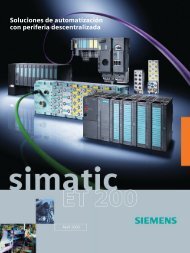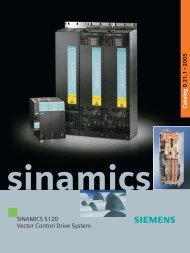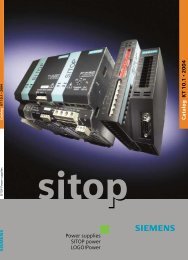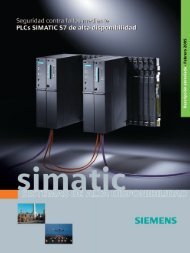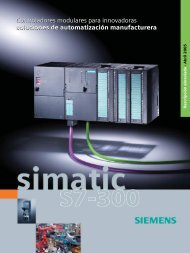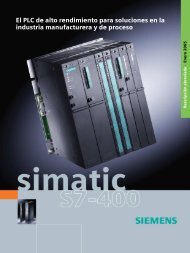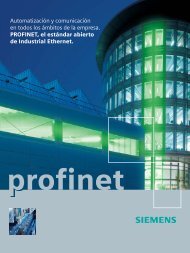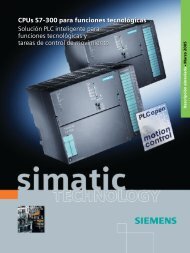SIMATIC PCS 7 process control system
SIMATIC PCS 7 process control system
SIMATIC PCS 7 process control system
You also want an ePaper? Increase the reach of your titles
YUMPU automatically turns print PDFs into web optimized ePapers that Google loves.
Process I/O<br />
The right solution for every requirement<br />
The <strong>SIMATIC</strong> <strong>PCS</strong> 7 <strong>process</strong> <strong>control</strong> <strong>system</strong> offers various possibilities<br />
for connecting I/O devices as well as for detecting and<br />
emitting <strong>process</strong> signals through sensors and actuators:<br />
■ Analog and digital I/O modules of the <strong>SIMATIC</strong> S7-400 operated<br />
centrally in the automation <strong>system</strong><br />
■ ET 200M, ET 200S, ET 200iSP distributed I/O <strong>system</strong>s with<br />
an extensive range of cost-effective signal and function<br />
modules, connected through PROFIBUS DP to the automation<br />
<strong>system</strong> (AS)<br />
■ Direct AS connection of intelligent, distributed field/<strong>process</strong><br />
devices and operator terminals through PROFIBUS<br />
DP/PA (also redundant or in hazardous zones 1 or 2, sensors<br />
also in zone 0)<br />
In practice, automation in the field area is largely characterized<br />
by distributed <strong>process</strong> I/Os:<br />
■ ET 200 remote I/Os in conjunction with classical field/<strong>process</strong><br />
devices and HART field devices as well as<br />
■ intelligent field/<strong>process</strong> devices directly on PROFIBUS.<br />
In addition to the wide technical bandwidth, the following<br />
properties speak for the distributed <strong>process</strong> I/Os:<br />
■ Modularity and uniformity<br />
■ Flexible adaptability to the plant structure<br />
■ Minimum cabling and engineering requirements<br />
■ Low commissioning, servicing and lifecycle costs.<br />
On the other hand, <strong>SIMATIC</strong> S7-400 signal modules used centrally<br />
in the automation <strong>system</strong> have little significance in the<br />
context of <strong>SIMATIC</strong> <strong>PCS</strong> 7. These modules are at most an alternative<br />
to distributed I/Os for small applications or plants with<br />
limited distributed expansion.<br />
ET 200iSP with redundant power supply<br />
Possible online modifications among the <strong>process</strong> I/Os<br />
ET 200M<br />
ET 200iSP<br />
ET 200S<br />
PROFIBUS DP, PROFI-<br />
BUS PA<br />
• Adding of ET 200M stations<br />
• Adding of I/O modules for the station<br />
• Reparameterization of I/O modules<br />
• Parameterization of connected HART<br />
field devices with <strong>SIMATIC</strong> PDM<br />
• Adding of ET 200iSP stations<br />
• Adding of modules for the station<br />
• Reparameterization of modules<br />
• Adding of ET 200S stations<br />
• Adding of PROFIBUS DP stations<br />
• Adding of DP/PA links and field devices<br />
• Parameterization of field devices with<br />
<strong>SIMATIC</strong> PDM<br />
Standard <strong>process</strong> I/Os for <strong>SIMATIC</strong> <strong>PCS</strong> 7<br />
The following standard <strong>process</strong> I/Os are recommended for the<br />
<strong>SIMATIC</strong> <strong>PCS</strong> 7 <strong>process</strong> <strong>control</strong> <strong>system</strong> for automation in the<br />
field area:<br />
■ ET 200M distributed I/O <strong>system</strong><br />
■ ET 200iSP distributed I/O <strong>system</strong><br />
■ ET 200S distributed I/O <strong>system</strong><br />
■ PROFIBUS PA devices according to PA profile 3.0<br />
Further <strong>process</strong> I/Os can be integrated into <strong>SIMATIC</strong> <strong>PCS</strong> 7 via<br />
the PROFIBUS using add-on blocks. Some examples include:<br />
■ SIMOCODE pro motor management <strong>system</strong><br />
■ MICROMASTER 3/4 frequency converters<br />
■ SIWAREX M/U/FTA/FTC weighing <strong>system</strong>s<br />
Process I/O 47




